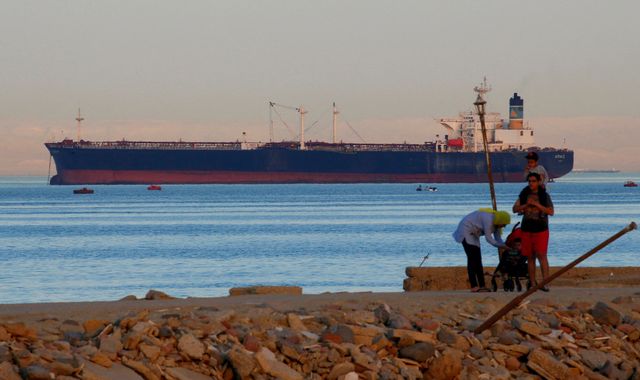Attacks on Red Sea shipping forces 66% decline in Suez Canal traffic - ONS
24 April 2024, 12:08 | Updated: 24 April 2024, 15:31

Shipping traffic through the vital Suez Canal artery in Egypt has plunged by 66% since cargo was forced to divert due to attacks on vessels, according to official figures.
The data, from the UK's Office for National Statistics (ONS), covered the period from mid-December to the beginning of April.
It is important as it represents the scale of disruption to supplies through the artificial channel linking the Mediterranean Sea to the Red Sea since Iran-backed Houthi fighters started firing on ships in the run-up to Christmas last year.
There are fears that soaring costs for insurance, fuel and wages risk stoking a fresh wave of inflation as the diversion to Europe from destinations such as manufacturing powerhouse China, around the southern tip of Africa, adds up to 14 days to transit times.
Separate ONS data covering the pace of price increases is yet to show any real impact on the UK economy but the Bank of England is among institutions monitoring the situation as a number of companies report a hit from higher costs.
Container prices, for example, rose by more than 300% as the disruption gathered pace early this year.
Houthi fighters based in Yemen have been targeting ships which, they claim, have links to Israel.
They argue that they are acting in sympathy with Palestinians and a number of attacks have found their targets despite a US-led naval operation to protect vessels in the Red Sea.
The vast majority of major shipping companies have, for some months, used the diversion around the Cape of Good Hope.
The ONS said volumes started to increase in December 2023 and throughout the first weeks of 2024, more than doubling levels observed in February 2023.
"By the first week of April 2024 (week 14), the volume of cargo and tanker ships through the Suez Canal was 71% and 61% below the level of ship crossings seen in the previous year, respectively."
It added that weekly crossings through the Strait of Hormuz, off the coast of Iran between February and April, showed a "significant decrease" compared with previous years.
It noted that shipping journeys were particularly low between weeks five and 10, with an average 23% reduction in crossing volumes compared with the same weeks in the previous year.
This was mainly due to lower tanker crossings, it noted.
Read more:
Why are the Houthis attacking ships in the Red Sea and what does it mean for inflation?
Iranian navy seizes tanker in Gulf of Oman
The prospect of more perilous journeys for tankers has been a factor behind rising oil prices.
Brent crude, which had been trading around the $80 a barrel mark at the start of the year, rose as high as $91 earlier this month amid the see-saw of tension across the conflict in the Middle East.
It culminated in tit-for-tat attacks between Israel and Iran.
It is currently trading at $88, reflecting the lack of escalation since last week.
The AA reported on Tuesday that average petrol costs in the UK had crossed back above the 150p-a-litre mark for the first time since November.
Experts have warned that they probably have further to go, with a weaker pound versus the dollar this month adding to higher oil costs as the commodity is priced in the US currency.
(c) Sky News 2024: Attacks on Red Sea shipping forces 66% decline in Suez Canal traffic - ONS

























